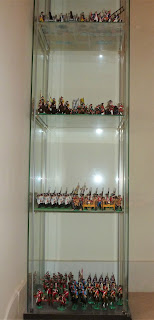The date for our next game had been in the diary for a couple of months and we talked about trying something different, but as the day drew nearer one of my cats broke a leg, which rather changed the dynamic in our calm and peaceful household. Rather than postpone we opted for something easy to set up and play, but still wanted something a bit different. A quick search through the scenarios on the
Command and Colours website gave us Garibaldi's invasion of Sicily in 1860 and the Battle of Calatafimi.
Garibaldi has landed and declared himself dictator of Sicily, as he marches on the capital, Palermo, the Neapolitan General Staff send General Landi to block him and put down the popular insurrection. As usual we were playing a wargame with 54mm toy soldiers, here's how it went:

The opening positions find Garibaldi and Bixio with their 1,000 Red Shirts (the "Mille") occupying the village of Vita on the left, Major Sforza has rushed the Neapolitan infantry forward to occupy the hills of Pianto dei Romani in the centre. On the hills beyond we can just make out the Picciotti, local militia, who have turned out to support the uprising. On the right we find General Landi in Calatafimi bringing up the rest of the Neapolitan troops.
The Neapolitan troops have been pushed forward to occupy the hills, the artillery is served by seasoned professionals, the infantry are well trained and armed but are raw recruits, if they lose a morale check they will fall back two hexes.
General Landi in Calatafimi rouses the Chasseurs and reserve infantry, but they won't move out until after the fourth turn.
Garibaldi's Mille advance on the hills from the village of Vita. Garibaldi himself can be seen leading the unit on the right, his second in command, Bixio is with the units on the left.
The Picciotti, poorly trained and armed, sit in the hills waiting to see what will happen, the scenario prevents them from taking any part in the action until after the fourth turn, their combat effectiveness is also reduces by 25%
The Neapolitan infantry wait apprehensively, overlooking the well cultivated valley, they can hear the Red Shirts approaching but their line of sight is blocked by the woods on the hills opposite.
Both sides move into contact in the centre
The action in the centre flows back and forth attack being met with counterattack and both sides giving good account of themselves.
A few well placed rounds from the Neapolitan artillery on the right flank has pinned down the Picciotti in their hills and things are looking desperate for the Red Shirts
The Neapolitan reserve finally get under way but it's too little, too late and the game will be over before they arrive.
Through shear force of personality Garibaldi leads his men in one final charge and breaks the Neapolitan line, as the enemy fall back in disorder the game is suddenly over.
The game played out in very much the same way as the actual battle 169 years ago, I guess that's the mark of a well designed scenario. The figures are nearly all conversions from various American Civil War figures and the practised eye should be easily able to distinguish their origin, I counted seven different manufacturers making up the Red Shirts. The game involved a lot of different terrain features, which took a while to set up and get acquainted with, but after that it moved very fast and we were done in about two hours.






















































